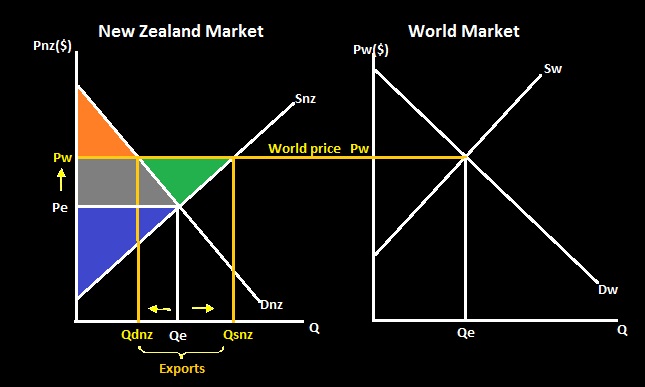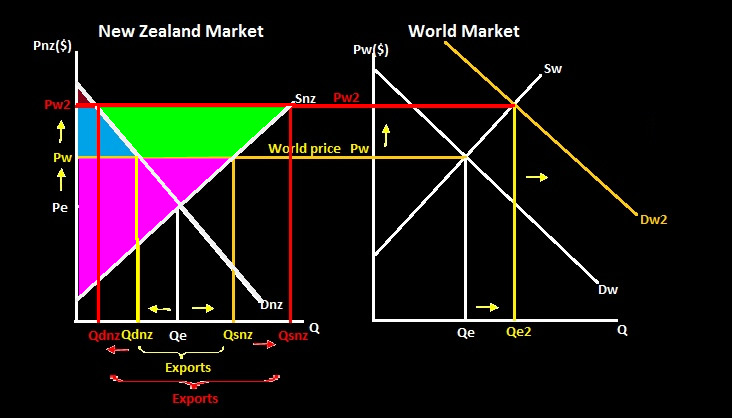TRADE
If the price in New Zealand is higher than the world price and free trade occurs, then New Zealand will import the lower price goods from overseas. This situation will continue for as long as there is free trade. The domestic market is interacting with the world market, with domestic buyers and sellers altering their behaviour in response to the world price. Effectively there is a new supply curve, sloping upwards at prices below the world price level following the domestic supply curve, then running horizontal at the level of the world price. The world supply is effectively infinitely elastic because of the large number of sellers to a small market (NZ) any change in selling conditions in NZ will have little or no effect on the world supply. |
|
With trade, the price in NZ will fall to the world price. This will cause an increase in the consumer surplus from the area in yellow to the area in yellow, blue and green. NZ domestic producer surplus will fall from the area in red, and blue to just the area in red. |
 |
IMPACT OF A TARIFF A tariff will increase the domestic price making NZ firms more competitive and therefore increasing the supply of the NZ product. There will be less imports and demand for the product in NZ will decrease. The tariff will cause consumer surplus to fall from the area in yellow and blue to just the area in blue. Domestic Producer surplus will increase from the area in red to the the area in red and brown. The government will gain revenue from the tax (the area in grey) but the gain in producer surplus and government revenue is less than the loss in consumer surplus and so there is a deadweight loss - shown by the areas in pink. |
 |
If the world price is above the price in NZ, then NZ will export to the world market. As NZ is such a small country, in reality we have very little control over the world price and so NZ tends to be an accepter of what ever price the world market imposes. The Price Elasticity of Demand for New Zealand's products tend to be Elastic. A lot of goods NZ exports such as wool, dairy products, meat etc, have many substitutes across the world and so an increase in the price of NZ's products will lead to a larger decrease in the quantity demanded.
|
|
With trade, the price in NZ will increase to the world price. This will cause a decrease in the consumer surplus from the areas in orange and greyto the area in orange only. NZ domestic producer surplus will increase from the area in blue to the areas in blue, grey and green. |
 |
With an increase in world demand, the world price will increase. This will lead to an increase in price in NZ and therefore an increase in Exports. The Quantity Demanded by NZ domestic consumers will decrease and so the Consumer Surplus will also decrease from the areas in Blue and Brown. Domestic Producer production will increase as NZ Exports more. Producer Surplus will increase from the area in Pink to the areas in in Pink, Blue and Green.
|
 |
With an increase in Supply in New Zealand (caused by things like an increase in productiivty, decrease in the costs of production etc), there will be an increase in Exports and an increase in Domestic Producer Surplus fro the area in Blue to the areas in Blue and Silver. Consumer Surplus will stay the same - the area in Orange. |
 |